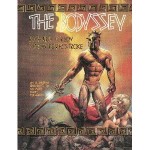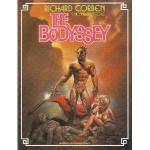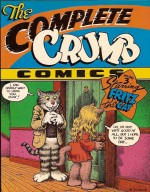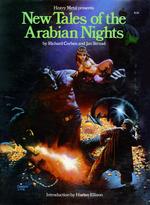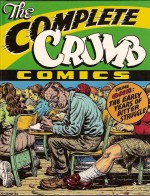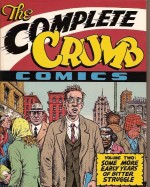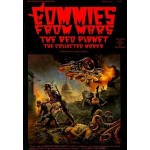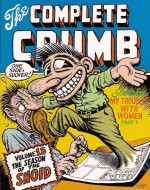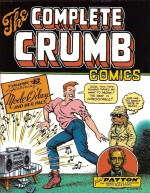
By various, edited by Sammy Harkham (PictureBox)
ISBN: 978-0-98458-927-2
Since the 1980s when “Underground†creators and cartoonists of adult and mature English-language comics first began to find mainstream and popular acceptance by re-branding themselves as alternative or Avant Garde, there have periodically emerged groundbreaking anthologies which served to disseminate the best of the best in challenging sequential art. Following on the groundbreaking heels of Raw and its descendants, Kramers Ergot launched as a 48-page mini-comic in 2000 and grew into a vari-format, anything goes visual and intellectual banquet before suspending publication with #7 in 2008 with a hugely proportioned (536x414mm) 96-page deluxe hardback starring sixty of the art form’s most beguiling pantheon of stars.
Now founding father Sammy Harkham returns with another stunning array of top-notch new creations and a smattering of sublime vintage material in a gloriously accessible 240-page clothbound B-format hardback that once more brandishes the sharpest of cutting edges at fans of the medium at its most uncompromising…
The magic begins with the abstract and glittering Overture by Robert Beatty, after which Washington Punk musician Ian F. Svenonius (Nation of Ulysses, Weird War and Chain and The Gang) contributes a fascination and informative essay on the shape of American arts with Notes on Camp part 2.
Alternative star and social commentator ‘Jimbo’ returns in a trek across tomorrow’s wastelands in a sharp monochrome yarn from Gary Panter after which C.F. explores isolation and human relationships in the placidly eerie ‘Warm Genetic House-Test Pattern’ whilst Kevin Huizenga redraws an old Charlton Comics fantasy tale (“The Half Men†by Bill Molno & Sal Trapani and possibly scripted by the prolific Joe Gill) in the quirkily disturbing ‘Mysteries of Unexplained Worlds’…
Leon Sadler produces the first of two contributions in the colourfully pensive ‘Friendship Comic’ whilst the muted hues and jolly style of Gabrielle Bell’s ‘Cody’ successfully belies the tale’s violent underpinnings and Frank Santoro & Dash Shaw shock and stun with their chilling ‘Childhood Predators’.
‘Ain’t it So?’ is a smart cartoon by Tim Hensley and ‘Get Your Ass to Mars’ is a set of stunning art photo pieces from Takeshi Murata, whilst ‘Mining Colony X7170’ is a typically dark and savage sci fi shocker from anti-art iconoclast Johnny Ryan before
Leon Sadler returns with the expansive and picaresque ‘Goblins Orbit the Earth (I’m Here! It’s Me!)’.
Chris Cilla takes a different look at love in ‘Secret Tourist’ and ‘Barbarian Bitch’ by Anya Davidson joyously screws with all the traditions of the hoary old genre and Ben Jones plays cunning mind-games and perpetrates dire puns in his shaggy doggish and charmingly primitivist ‘The Ultimate Character 2002’ after which Editor Sammy Harkham picks up his own pens to describe the silent horror and driving melodrama of ‘A Husband and a Wife’.
‘Epilogue’ is another visual voyage from painter Robert Beatty and this tome concludes with a long lost delight.
The last contribution is a true joy for me reprinting as it does a selection from what I believe to be one of the most delicious and clever British strips ever created. ‘Oh, Wicked Wanda (Select Excerpts)’ reprints in sublime full glossy colour Ron Embleton & Frederick Mullalley’s brilliant socio-sexual satire which ran in Penthouse magazine between 1973-1980.
Journalist, editor (of left-wing magazine Tribune), columnist, novelist and political writer Mullally was hired to script the exotic, erotic adventures of Wanda Von Kreesus, the richest woman in the world, Candyfloss, her insatiable jailbait paramour and an outrageous coterie of faithful employees including an all-girl army, a mad scientist and a brutal looking thug with the soul of a poet. To illustrate he secured the talents of oil painter and comic strip veteran Ron Embleton who had astounded comic readers with his lush and vibrant strip Wulf the Briton in Express Weekly and his illustrations in Look and Learn.
Oh, Wicked Wanda! was originally a prose serial illustrated by Bryan Forbes, beginning in 1969 before becoming, in 1973, the unbelievably lavish and torrid strip reprinted here, continuing until 1980 when it was replaced by Sweet Chastity, also painted by Embleton, and scripted by Penthouse proprietor Bob Guccione.
The bored and mischievous hellion is a sexually adventurous woman from a time when sexual politics and liberation were huge issues, and therefore prime targets for low comedy and high satire. Mullally peppered his scripts with topical references (many, sadly which would escape today’s casual reader, I’m sure) and the phenomenal Embleton would depict them with hyper-realistic accuracy. Harold Wilson, Edward Heath, Ted Kennedy, Richard Nixon, Henry Kissinger, Fidel Castro, Lyndon Johnson, Spiro Agnew, Mao Tse-tung, John Wayne, Donald Duck, Mickey Mouse and even comic-strip greats like Pogo, Mutt and Jeff or Krazy Kat, all meandered through the glossy pages, a cross between a Greek Chorus and pictorial ad-libs.
Many celebrities were actively parodied, participants and classical and contemporary erotic allusions abounded; ranging from a little nymphette lounging about reading William Burroughs’s Naked Lunch to visual and verbal references to Shelley’s Leda and the Swan.
Here some of the earliest adventures are re-presented as Wanda destroys, debases, abducts and mounts (no, not necessarily that way) the obnoxiously rich and famous for her Museum of Misfits and Deviancy; consequently taking on the Mafia, the CIA and South American Nazi war criminal Martin Boorman. Her personal Mad Scientist Homer Sapiens also reveals his sordid connections to some of the 20th century’s nastiest personages…
Oh, Wicked Wanda! is still a funny, sexy read and inarguably one of the most beautiful British strips ever crafted. Hopefully this selection will lead to a new audience and a comprehensive reprinting …
As well as being a comics-lovers dream, Kramers Ergot is a book-lovers delight with excellent design and a reassuringly high-class print values. This package is something no lover of the medium can afford to miss.
All material © 2011 respective authors and owners. All rights reserved.

